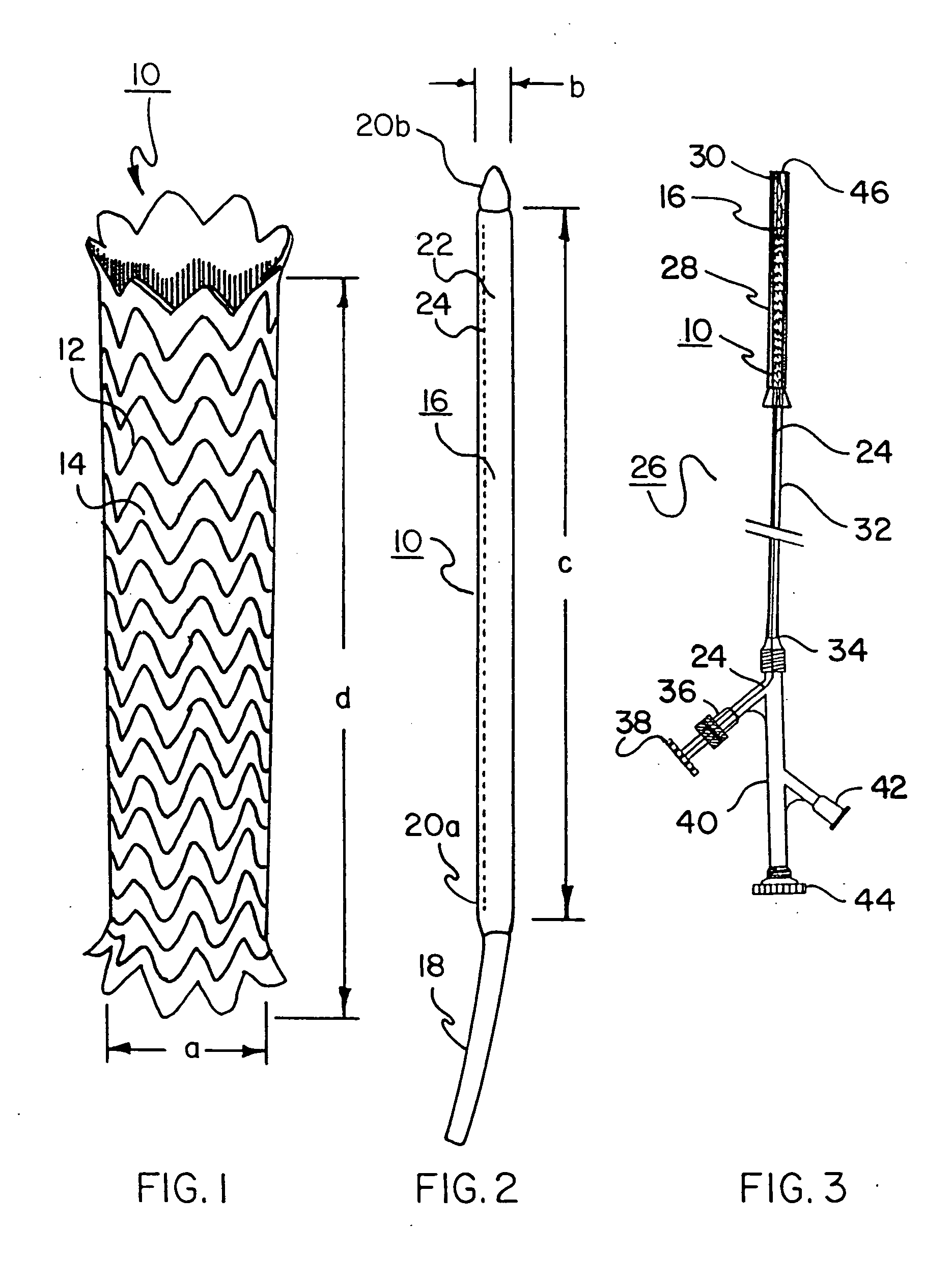Method of producing low profile stent and graft combination
a low-profile, graft technology, applied in the field of endoprosthetic devices, can solve the problems of limiting tissue encroachment into the device, increasing the risk of infection, and affecting the effect of treatment,
- Summary
- Abstract
- Description
- Claims
- Application Information
AI Technical Summary
Benefits of technology
Problems solved by technology
Method used
Image
Examples
example 1
[0127] A 40 mm inner diameter thoracic aortic stent-graft is created. The stent portion is built using 0.30 mm diameter, 40-45% cold worked NiTi (nitinol) wire (SE 508; Nibnol Devices & Components, Fremont, Calif.) formed using a mandrel with protruding pins. The stent is constructed using a single wire, creating an undulating, helical, tubular stent member by winding the wire on a pin fixture as described in the above-mentioned published PCT patent application. See FIGS. 7 through 9.
[0128] Once the wire is formed on the pin fixture, it is heat treated in a convection oven set at 450° C. for 15 minutes. After removal from the oven and quenching in a water bath, the wire frame is unwound from the fixture creating a freestanding tubular stent frame.
[0129] The stent cover is constructed from a strong, thin film. A suitable film comprises expanded PTFE (ePTFE) film made in accordance with the teachings of U.S. Pat. No. 5,476,589 to Bacino, incorporated by reference. This expanded PTFE...
example 2
[0139] Another 40 mm inner diameter thoracic aortic stent-graft is constructed using polyester as the stent covering material. The stent portion is constructed using 0.20 mm diameter nitinol wire (SE 508; 40-45% cold worked; Nitinol Devices & Components, Fremont, Calif.). Yellow polyester film (PES 30 / 25, available from Saatitech, Inc., Somers, N.Y.) is employed as the stent covering. The polyester material is approximately 0.046 mm thick. The stent member is formed and heat treated in the manner described above in Example 1. The stent covering is attached to the inner surface of the stent frame with CV-8 Sutures (available from W.L. Gore & Associates, Inc., Flagstaff, Ariz.), using a running stitch and tying the ends of the of the sutures together.
[0140] As in Example 1, the device is pulled down into a tapered fixture and contained within a capture tube containing a removable polyester inner liner. A 0.89 mm guidewire is inserted inside the stent-graft prior to compaction. A long...
example 3
[0142] A 26 mm inner diameter thoracic aortic stent-graft is constructed using 0.20 mm nitinol wire (SE 508; 40-45% cold worked; Nitinol Devices & Components, Fremont, Calif.) and ePTFE film. This stent-graft is made in the same manner, with the same materials, as described in Example 1 following the steps outlined in Table 1. The device is drawn down over a 0.89 mm diameter wire to simulate the presence of a guidewire. The stent-graft and wire are pulled into a polyester tube (fabricated as described in Example 1). The stent-graft plus polyester tube fits within a 6 F hole. The stent-graft deploys to 24 mm in a 36° C. water bath. Gently pulling the stent-graft over a tapered mandrel deploys the device to 26 mm.
[0143] The a:b ratio for this device is 13.3:1.
PUM
| Property | Measurement | Unit |
|---|---|---|
| diameter | aaaaa | aaaaa |
| diameter | aaaaa | aaaaa |
| diameters | aaaaa | aaaaa |
Abstract
Description
Claims
Application Information
 Login to View More
Login to View More - R&D
- Intellectual Property
- Life Sciences
- Materials
- Tech Scout
- Unparalleled Data Quality
- Higher Quality Content
- 60% Fewer Hallucinations
Browse by: Latest US Patents, China's latest patents, Technical Efficacy Thesaurus, Application Domain, Technology Topic, Popular Technical Reports.
© 2025 PatSnap. All rights reserved.Legal|Privacy policy|Modern Slavery Act Transparency Statement|Sitemap|About US| Contact US: help@patsnap.com



